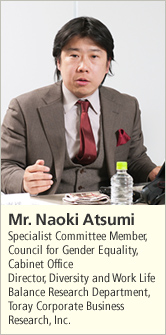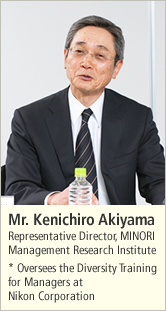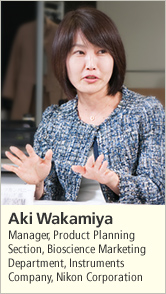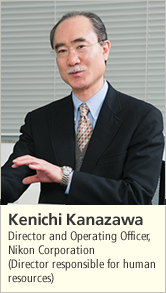Stakeholder Dialogue
Moving from the stage of understanding to actual implementation and real-life experience
—What kinds of measures are effective in creating a positive workplace culture? —
Okubo: In the dialogue so far we have found two main points: that there is a lack of awareness of women, and that women's career development can be held back by people around them being too reserved about women. With these points in mind, I'd like to move the discussion toward finding some common ground as to the directions that Nikon should pursue.
Atsumi: Companies that have succeeded in promoting the advancement of women have been thinking carefully about how to offer the maximum amount of support towards enabling women to play active roles in the workplace. These companies take responsibility for improvements in the work environment. Once the improvements are in place, they encourage women to be more active in the workplace. The women who were able to be successful with the support of these improvements are then in the position to give support to younger women who come after them. This cycle is also crucial. Moreover, in Japan in the future, giving care to elderly family members will become one of the most important issues for workers. Men, as well as women, will serve as caregivers. Recently the number of male caregivers in particular has been growing rapidly. Even if a system to support caregivers is in place, a workplace that cannot utilize it effectively may come to a standstill in proceeding with work. The culture of a workplace is more important than its systems. Creating a positive culture is one of the most important issues facing Nikon. A key point in this is whether or not men can be conscious and take initiative to tackle problems themselves.

Akiyama: During the diversity management training that we held at Nikon, there was one approach in particular that I thought worked very well. It was to make sure to include women in every training class. From the discussions held during training, men came to realize first-hand how women think about the issues. I think Nikon has cleared the stage of understanding the concept of diversity. The next step would be for Nikon to create several workplaces or project teams within the company which are actually diverse in nature. In a new environment, problems will occur on a practical level. When they arise, some people will raise negative views, such as, "Is there really any point in doing this?" But the key to promoting diversity is to have in-depth discussions which also include these negative views. Once examples of success emerge, efforts will pick up pace.
Atsumi: As Mr. Akiyama said, the next stage after understanding diversity is to experience it first-hand. To do this, I feel that providing "hands-on minority experiences" is extremely effective. By experiencing feelings of alienation and loneliness, people can personally understand the support needed by minorities. And perhaps only managers who can utilize such experiences will be able to acquire and show true management skills.

Okubo: In the dialogue between the specialists, two ideas were put forward: that creating a positive workplace culture is possibly even more important than creating systems, and that experiencing diversity is the next stage after understanding it intellectually. From your standpoint within Nikon, what are your thoughts on this?
Hakamata: As was pointed out, I think that although we have a surface-level understanding, we haven't really experienced diversity yet. I feel that it is crucial as a means of creating a positive workplace culture to first go back to where we started, and to consolidate and spread within the group the understanding of why exactly we are making efforts to promote diversity. I found the suggestion of having hands-on minority experiences also very interesting. An HR system that develops professionals is a good thing, but when considering the necessity to understand the diversity of people, there may be some room for improvement in relation to personnel transfers. Listening to the dialogue today, perhaps this could also lead to revitalization within the company.

Yoshida: The suggestion of personnel rotations reminded me of the necessity of giving a variety of experiences to people who will become leaders. At the Human Resources Department, rather than waiting for workplace attitudes and culture to change, we will take positive measures.
Wakamiya: I feel that the number of transfers from one company to another has decreased since we introduced the in-house company system. Because of this, there are cases in which people fall into a rut, for example, when looking at plans for products, which makes it harder for new ideas to arise. In that sense, first if people who have different viewpoints join an environment through a suggested personnel rotation system, they will revitalize the workplace. I also feel that in order for women to progress in their careers while keeping managerial positions in mind for the future, it is probably necessary to create opportunities for raising awareness through measures such as mentoring programs.
Godai: At my company we are working to some degree to provide opportunities to women, but the pace of our efforts needs to increase. We do implement personnel rotations, although on a small scale. But there are some workplaces with a concentration of women, and I think we must examine them as well.
Kanazawa: Indeed, the number of transfers between companies has gone down since the introduction of the in-house company system. There are now fewer opportunities for the mixing of different cultures. And Nikon might in itself be a company that has a low number of personnel transfers. There are many people who kept doing the same job even after the name of their department changed through organizational changes. Reducing the number of these kinds of employees is seen as an issue by top management. We hope to actively pursue the possibility of personnel rotations in the future as well.
Atsumi: There are two types of diversity. One is diversity of attributes including gender, nationality, age, etc. The other type is the diversity of individuals, or in other words, the differences between individual people. Acceptance of individual diversity energizes the workplace and, in the end, the whole company. It also helps the individuals themselves. Creating a workplace atmosphere in which a diverse selection of people can freely and dynamically state their various opinions is important from a compliance perspective as well. So I sincerely hope that companies deal with this issue as a challenge that affects all employees, rather than just a problem for women. There are cases in other companies of, for example, creating diversity forums where both employees and management are able to state their opinions. The discussion at such forums is used as one way to spread awareness diversity.

